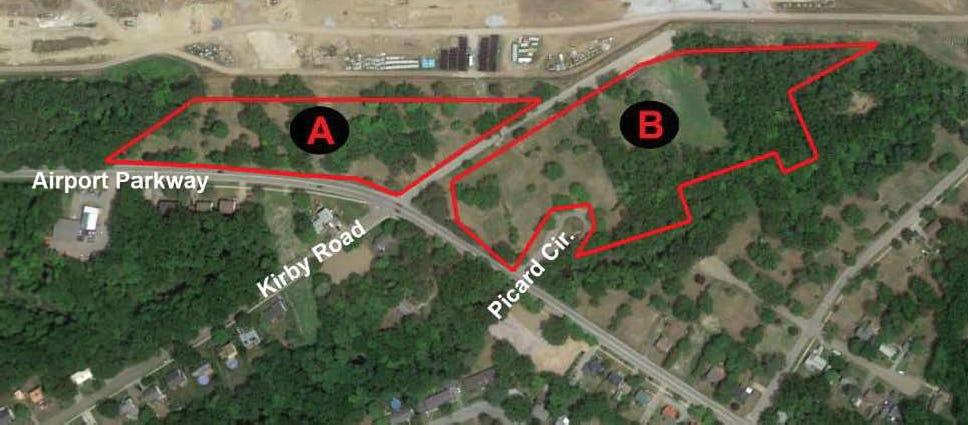Beware: Airport greenery plan is really a Trojan Horse
Acting airport director seeks to reverse the victory won by the Chamberlin neighborhood
A closer look at Acting Airport Director Nic Longo’s seemingly generous greenery gambit shows it to be a version of the Trojan Horse of old or of its modern electronic version: “a program designed to breach the security of a computer system while ostensibly performing some innocuous function.”
The airport’s offer followed a huge victory for the community over a previous airport expansion plan. Last month the South Burlington Planning Commission unanimously voted down the airport’s request to rezone 11 acres of the Chamberlin neighborhood from residential to airport industrial (see areas A and B on the map below where 23 houses once stood). The vote followed a months-long campaign by Chamberlin residents, dozens of whom spoke out against industrial development in their neighborhood at a pair of public hearings put on by an Airport Expansion Task Force set up by the South Burlington Planning Commission.
In a remarkable speech that seemed to graciously accept the denial of the airport’s rezoning request, Longo told the Planning Commissioners that he already had a substitute design for an airport maintenance building that would not encroach into the Chamberlin neighborhood. He further said that neighbors will continue to have access to the airport-owned 44-acre green space, and that he “wants to use all that green space for neighbors.” Going further, Longo told the Planning Commission that the airport would put in walking paths, park benches, and landscaping on the airport-owned land.
Greenery gambit revealed
In view of his conciliatory-sounding remarks, a group of community members met with Longo on Friday, June 3. At that meeting he revealed new plans to build that airport maintenance building on the airport’s industrial-zoned property—it would be on the edge of that airport property adjacent areas A and B instead of extending into those areas.
Longo then revealed the quid pro quo he seeks in exchange for providing the walking path, landscaping, and benches: he wants permission to use the landscaping he puts on the 44-acre green space to satisfy the city’s regulations governing landscaping for that new maintenance building and as "credit toward future projects." Thus, Longo withdrew from the unqualified offer he had made in his speech to the planning commission.
Fortunately, those city regulations have criteria that protect residential districts from new industrial development. The criteria specifically require “screening or buffering” where an “industrial . . . use abuts a residential district” (p. 210). They also require buildings to be set back from the edge of the property. They also require landscaping (p. 60 and p. 210) on site and especially thickly in the buffer zone at the edge of the site.
If, notwithstanding its own regulations, the city were to accept Longo’s proposal to use the 44-acre green space to satisfy the city’s landscaping regulations, the airport could squeeze more buildings and hangars on land directly fronting Chamberlin, position them closer to the residential neighborhood, and avoid the required screening or buffering. Such higher-intensity industrial activities would further disrupt that already F-35-disrupted residential district.
Sadly, the walking paths, park benches, and landscaping turned out to be a Trojan horse designed to extend the breach of security, health, and welfare of an entire neighborhood of 1000 working class families. A neighborhood already suffering under the 115-decibel F-35. Longo’s ploy is also designed to avert the return of housing to the now-vacant 44 acres of land (of which the 11 acres are a part) where some 200 affordable homes were demolished because of the blasting F-16 afterburner and to make way for the F-35.
The Chamberlin neighborhood already proved itself to be no doormat
Fresh from their victory halting Longo’s previous rezoning request, residents are unlikely to fall for Longo’s latest subterfuge. Community members have multiple ways to expose the airport director’s duplicity and press their case if Longo persists with his Trojan horse tactic: Speaking out at public hearings called by the South Burlington City Council, Planning Commission, or Development Review Board for enforcement of South Burlington regulations and against any variance is one. Calling on the Burlington City Council to reject any FAA grant that could impede return of the 44 acres to housing is another.
Money talks
A defeat of the airport’s new greenery gambit could finally force the airport, the mayor, and the developers to recognize that the only way to monetize the airport’s incredibly valuable 44-acre landholding is to sell the land to build hundreds of desperately needed affordable houses and apartments.
Consider, by comparison, that City Place, in downtown Burlington, has an approved plan to build over 400 housing units on just 3 acres. Imagine how 44 acres in such a central-city location in South Burlington could be used for housing in a way that preserves the character of the Chamberlin neighborhood.
At a time of crushing housing crisis, the airport is standing in the way of hundreds of units of affordable housing, tens of millions of dollars of benefit to the community, and construction jobs galore.
But all that revitalizing economic activity rides on ending the 115-decibel F-35 training flights where they don’t belong, in a densely populated area.
Burlington has the power, and housing is desperately needed
Instead of trickery, the Acting Airport Director must make good on his unqualified promise to work with the community: Use the 44 acres the airport owns for desperately needed affordable houses and apartments. Use Burlingon’s airport proprietor powers and authorities (see paragraphs 13.2a(2)-(3) and b(2) & (6) and 11.5c in this FAA document) that allow Burlington to “limit equipment, personnel, or practices that are unsafe, unsightly, or detrimental to the public welfare.” Thus, the FAA expressly provides the City of Burlington with the power to put a stop to the 115-decibel F-35 training flights in the state’s most densely populated area, the Chamberlin neighborhood and the Cities of Winooski and Burlington.
As the US Air Force wrote that the Burlington airport’s civilian aircraft noise was negligible compared to its military jet noise, once that 115-decibel F-35 noise stops, FAA grant assurances (see assurance 31) will require the airport to sell the land for housing.
In addition, public officials, including airport officials, must insist that the Vermont Air National Guard enforce federal regulations governing their conduct, including Department of Defense Directive 2311.01: “Distinction” requires commanders to conduct such military operations as training with F-35 jets remote from populated areas, not in densely populated cities.
The halting of the F-35 training in cities, and the return of a huge amount of affordable housing to the 44 acres would restore the security, health, safety, welfare, and integrity of the Chamberlin neighborhood, fill the coffers of the airport with money, and add substantially to the tax base of the City of South Burlington. That’s worth fighting for.
Write or call your public servants and demand an immediate halt to F-35 training in cities.
Governor Phil Scott 802-828-3333 Chief of Staff <Jason.Gibbs@vermont.gov>
Vermont National Guard's Complaint Line: 802-660-5379 (Note: the Vermont Guard told a reporter that it received over 1400 noise complaints. But the Guard won’t release what people said).
Submit your report & complaint to the still-active online F-35 Fall 2021-Winter 2022 Report & Complaint Form: https://tinyurl.com/5d89ckj9
See all the graphs and in-your-own words statements on the F-35 Spring-Summer 2021 Report & Complaint Form (513 responses): https://tinyurl.com/3svacfvx.
See links to the graphs and in-your-own words statements on all four versions of the F-35 Report & Complaint Form since Spring 2020, with a total of 1670 responses from 658 different people plus 70 more on the still-active form.
Senator Patrick Leahy 800-642-3193 Chief of Staff <john_tracy@leahy.senate.gov>
Senator Bernie Sanders 800-339-9834 <Senator@sanders.senate.gov>
Congressman Peter Welch 888-605-7270 Chief of Staff <patrick.satalin@mail.house.gov>
Burlington City Council <citycouncil@burlingtonvt.gov>
Burlington Mayor Miro Weinberger <mayor@burlingtonvt.gov>
Winooski Mayor Kristine Lott <klott@winooskivt.org>
S. Burlington City Council Chair Helen Riehle <hriehle@sburl.com>
Williston Selectboard Chair Terry Macaig <macaig@msn.com>
VT Senate President Becca Balint <bbalint@leg.state.vt.us>
VT House Speaker Jill Krowinski <jkrowinski@leg.state.vt.us>
Attorney General TJ Donavan <DonovanTJ@gmail.com>
States Attorney Sarah George <Sarah.fair.george@gmail.com>
Vermont’s Federal Prosecutor <usavt.contactus1@usdoj.gov>
Adjutant General Brig Gen Gregory C Knight <gregory.c.knight.mil@mail.mil>
Major J Scott Detweiler <john.s.detweiler.mil@mail.mil>
Wing Commander Col David Shevchik david.w.shevchik@mail.mil
Vermont National Guard Inspector General Lt. Col. Edward J Soychak <edward.soychak@us.af.mil>
US Air Force Inspector General Lt. Col. Pamela D. Koppelmann <pamela.d.koppelmann.mil@mail.mil>
Air Force Secretary Frank Kendall <Frank.Kendall@us.af.mil>







May the citizens prevail~and may those who have destroyed the peace by tearing down homes, basing the F35s in a heavily populated area against Air Force Regs, and harming the people who live in the communities surrounding the airport...be voted out if they are in elected office or fired for crimes against humanity~thank you James Marc Leas and all of those who have been working to bring the quiet and calm back to these neighborhoods~and for working on behalf of human rights everywhere as others fight to keep F35s out of their neighborhoods~Marjorie